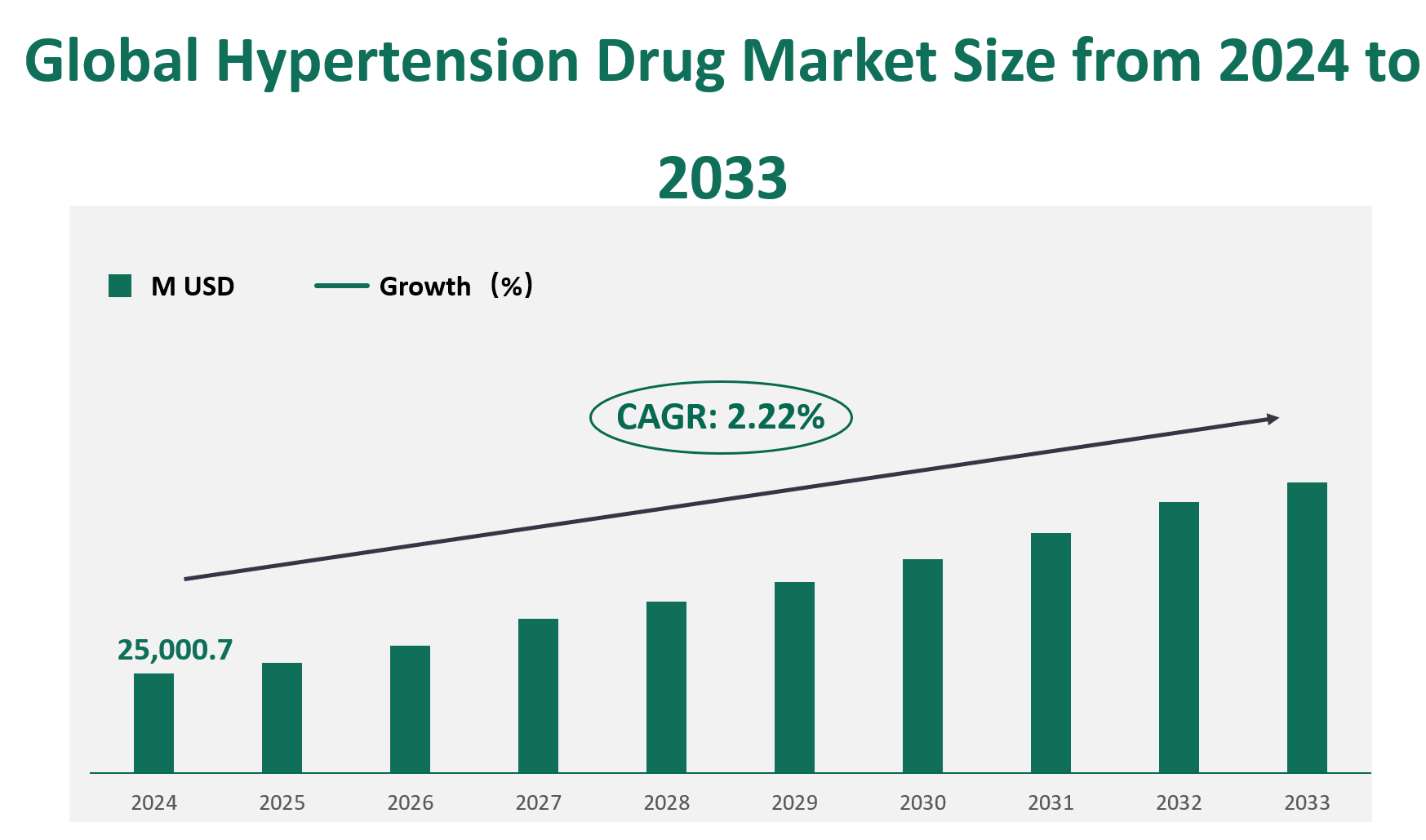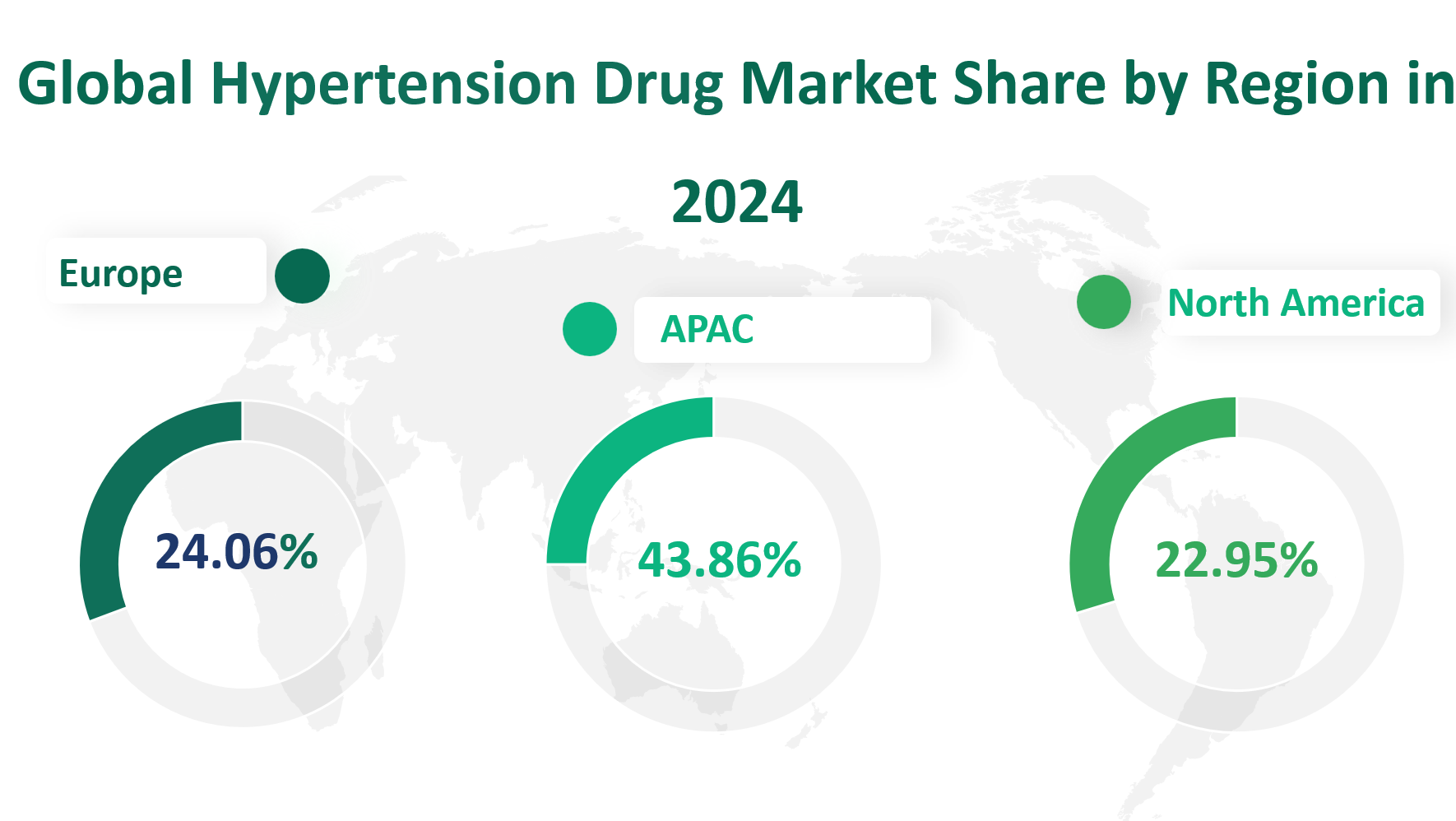1. Global Hypertension Drug Market Insight Analysis
In 2024, the global hypertension drug market is projected to reach a revenue of 25,000.7 million USD, with a Compound Annual Growth Rate (CAGR) of 2.22% from 2024 to 2033.
Hypertension, commonly known as high blood pressure, is a chronic medical condition that affects a significant portion of the global population. It is characterized by elevated blood pressure levels, which can lead to severe health complications such as heart disease, stroke, and kidney failure if left untreated. Hypertension drugs are medications specifically designed to lower blood pressure and mitigate the risks associated with this condition. These drugs work through various mechanisms, including relaxing blood vessels, reducing fluid retention, or blocking hormones that cause blood vessels to constrict.
The primary goal of hypertension drugs is to maintain blood pressure within a healthy range, thereby reducing the strain on the heart and other vital organs. The market for these drugs is vast, encompassing a wide range of pharmaceutical products, from traditional medications like diuretics and beta-blockers to newer, more advanced treatments such as angiotensin-converting enzyme (ACE) inhibitors and angiotensin II receptor blockers (ARBs). The importance of hypertension drugs cannot be overstated, as they play a crucial role in preventing cardiovascular events and improving the quality of life for millions of patients worldwide.
Figure Global Hypertension Drug Market Size (M USD) and CAGR (2024-2033)

2. Driving and Limiting Factors of Hypertension Drug Market Growth
The growth of the global hypertension drug market is influenced by several key factors. On the positive side, the increasing prevalence of hypertension, driven by aging populations and lifestyle changes, is a major growth driver. Hypertension is a leading risk factor for cardiovascular diseases, and its incidence has been rising steadily, particularly in low- and middle-income countries. This trend has led to a growing demand for effective hypertension drugs.
Additionally, advancements in medical research and the development of new drug formulations have improved the efficacy and safety of hypertension treatments. Governments and healthcare organizations are also promoting awareness campaigns to encourage early diagnosis and treatment of hypertension, further boosting market demand.
However, there are also several limiting factors that could hinder the growth of the hypertension drug market. One significant challenge is the low awareness and treatment rates in many regions, particularly in underdeveloped areas. Many patients remain undiagnosed or do not adhere to prescribed treatment regimens, which reduces the overall market demand.
Another factor is the increasing competition from generic drugs, which have lower prices compared to branded medications. This has led to downward pressure on prices, affecting the revenue potential for pharmaceutical companies. Additionally, the development of alternative treatments, such as medical devices and lifestyle interventions, could potentially reduce the reliance on drug therapy in the future.
3. Technology Innovation and Corporate Mergers and Acquisitions in Hypertension Drug Market
The hypertension drug market is witnessing significant technological innovations aimed at improving treatment efficacy and patient outcomes. One notable trend is the development of combination therapies, which integrate multiple active ingredients into a single pill. This approach not only enhances the therapeutic effect but also improves patient compliance by simplifying the dosing regimen.
Additionally, advancements in drug delivery systems, such as extended-release formulations, are allowing for more convenient and effective administration of hypertension drugs. Pharmaceutical companies are also investing in research to develop new classes of drugs that target novel pathways involved in blood pressure regulation.
Corporate mergers and acquisitions (M&A) have become a strategic tool for companies to expand their product portfolios and enhance their market positions. For example, Lupin Limited acquired Southern Cross Pharma in Australia in 2021, significantly increasing its market share and product offerings in the region. Similarly, AstraZeneca divested a suite of hypertension drugs to Atnahs in 2020, focusing on its core business areas while allowing the buyer to capitalize on the existing market demand. These strategic moves reflect the dynamic nature of the hypertension drug market, where companies are constantly seeking opportunities to innovate and consolidate their positions through partnerships and acquisitions.
4. Global Hypertension Drug Market Size by Type
Calcium Channel Blockers (CCBs) are medications that work by preventing calcium from entering the cells of the heart and blood vessels. This action helps to relax and widen the blood vessels, thereby reducing blood pressure. In 2024, the market revenue for Calcium Channel Blockers is projected to reach $7,331.9 million USD. These drugs are widely used due to their efficacy and relatively low side effects, making them a cornerstone of hypertension treatment.
Diuretics, often referred to as “water pills,” are used to reduce blood pressure by helping the kidneys eliminate excess sodium and water from the body. This reduction in fluid volume lowers the pressure within the blood vessels. In 2024, the market revenue for Diuretics is expected to be $939.5 million USD. Diuretics are particularly effective for patients with fluid retention and are often used in combination with other hypertension drugs.
Beta Blockers work by blocking the effects of the hormone epinephrine (adrenaline), which helps to slow the heart rate and reduce the force of contractions. This action lowers blood pressure and reduces the heart’s workload. The market revenue for Beta Blockers in 2024 is projected to be $2,706.5 million USD. These drugs are commonly used for patients with hypertension and other cardiovascular conditions, such as angina and heart failure.
Angiotensin-Converting Enzyme (ACE) Inhibitors are medications that prevent the body from producing angiotensin II, a substance that narrows blood vessels. By blocking this hormone, ACE inhibitors help to relax and widen blood vessels, thereby lowering blood pressure. In 2024, the market revenue for ACE Inhibitors is expected to reach $4,329.7 million USD. These drugs are particularly effective for patients with hypertension and are often used in combination with other medications.
Angiotensin II Receptor Blockers (ARBs) work similarly to ACE inhibitors but block the effects of angiotensin II directly. This mechanism helps to relax blood vessels and lower blood pressure. In 2024, the market revenue for ARBs is projected to be $5,679.9 million USD. ARBs are often prescribed for patients who cannot tolerate ACE inhibitors due to side effects.
Vasodilators are medications that work by relaxing the muscles in the walls of blood vessels, allowing them to widen and improve blood flow. This action reduces the pressure within the blood vessels. The market revenue for Vasodilators in 2024 is expected to be $776.4 million USD. Vasodilators are typically used in combination with other hypertension drugs to achieve optimal blood pressure control.
Alpha Blockers work by blocking the effects of norepinephrine, a hormone that causes blood vessels to constrict. This action helps to keep blood vessels open and relaxed, thereby lowering blood pressure. In 2024, the market revenue for Alpha Blockers is projected to be $955.2 million USD. These drugs are often used for patients with hypertension and other conditions, such as prostate enlargement.
Table Global Hypertension Drug Market Size by Type in 2024
Market Size (M USD) 2024 | Market Share | |
Calcium Channel Blockers | 7331.9 | 29.33% |
Diuretics | 939.5 | 3.76% |
Beta Blockers | 2706.5 | 10.83% |
Angiotensin Converting Enzyme Inhibitors | 4329.7 | 17.32% |
Angiotensin-2 receptor blockers | 5679.9 | 22.72% |
Vasodilators | 776.4 | 3.11% |
Alpha Blockers | 955.2 | 3.82% |
Others | 2281.6 | 9.13% |
5. Global Hypertension Drug Market Size by Application
Hospitals are healthcare institutions that provide comprehensive care, including the treatment of hypertension. These settings often involve more severe cases of hypertension or patients with multiple comorbidities. In 2024, the market revenue for hypertension drugs used in hospitals is projected to be $12,934.5 million USD. Hospitals account for a significant portion of the market due to the high volume of patients treated and the complexity of care required.
Clinics are outpatient settings where patients receive routine care, including the management of chronic conditions like hypertension. Clinics are often the first point of contact for patients and play a crucial role in the long-term management of hypertension. In 2024, the market revenue for hypertension drugs used in clinics is expected to be $9,446.9 million USD. The clinic setting is characterized by a high frequency of patient visits and the need for ongoing medication management.
Table Global Hypertension Drug Market Size by Application in 2024
Application | Market Size (M USD) 2024 | Market Share |
Hospital | 12934.5 | 51.74% |
Clinic | 9446.9 | 37.79% |
Others | 2619.2 | 10.48% |
6. Global Hypertension Drug Market by Top Regions
North America is expected to generate a revenue of $5,736.6 million USD in 2024. This region has historically been a significant market for hypertension drugs, driven by high awareness levels, advanced healthcare infrastructure, and a large patient population.
Europe is anticipated to contribute $6,015.0 million USD to the global hypertension drug market in 2024. The region’s market is characterized by a high demand for innovative and effective treatments, driven by an aging population and increasing prevalence of hypertension.
Asia-Pacific is projected to be the largest regional market in 2024, with a revenue of $10,966.4 million USD. This region’s dominance is attributed to its large population base, particularly in countries like China, Japan, and India.
Latin America is expected to generate a revenue of $1,458.2 million USD in 2024. The region’s market is characterized by a growing middle-class population and increasing awareness of hypertension management.
Middle East & Africa is projected to contribute $824.4 million USD in 2024. While this region has a smaller market size compared to others, it is experiencing significant growth due to increasing healthcare investments and the adoption of modern medical practices..
Figure Global Hypertension Drug Market Size by Region in 2024

7. Global Hypertension Drug Market Analysis by Major Players
Novartis AG is a leading global pharmaceutical company headquartered in Basel, Switzerland. Founded in 1996, Novartis operates through segments such as Innovative Medicines, Sandoz, and Corporate. The company offers a wide range of hypertension drugs, including Diovan and Diovan HCT, which are widely used for lowering blood pressure. In 2022, Novartis AG generated a revenue of $1,591.4 million USD from its hypertension drug portfolio.
AstraZeneca Plc is a UK-based pharmaceutical company with a strong focus on cardiovascular, renal, and metabolic diseases. Established in 1913, AstraZeneca offers a variety of hypertension drugs, including Plendil, which is used for treating hypertension and angina. In 2022, the company’s hypertension drug revenue reached $1,091.1 million USD.
Bayer AG is a German multinational pharmaceutical and life sciences company founded in 1863. Bayer’s hypertension drug portfolio includes Adalat, a calcium channel blocker used for treating high blood pressure and angina. The company generated a revenue of $913.9 million USD from hypertension drugs in 2022.

